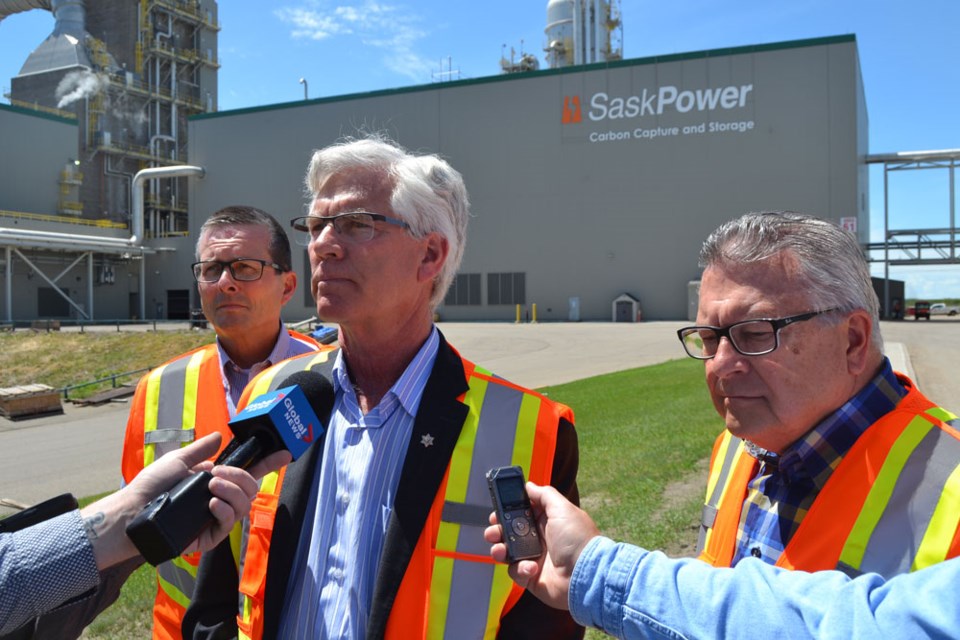The carbon capture and sequestration (CCS) unit at Boundary Dam and the technology it utilizes continue to attract the attention of the federal government. This attention came in the form of a visit and tour of the facility on July 6. Federal Minister of Natural Resources Jim Carr toured the CCS unit, accompanied by Regina MP and Public Safety Minister Ralph Goodale, Saskatchewan Environment Minister Herb Cox and SaskPower CEO Mike Marsh.
Carr’s tour of the facility was done to get information for the federal government, which he said needs to learn more about the technology. Carr described the needs of progressive federal initiatives to reduce greenhouse gas (GHG) emissions as “the point where technology meets public policy.”
He said that the CSS technology in place at Boundary Dam, has achieved a global level of recognition.
“We know what the International Energy Agency said, and they are probably the most important think tank talking about this technology in the world. They say we’re going to need it as we move towards our aggressive climate goals,” said Carr. “People are coming from every continent to look at this technology, to assess how it can help them reduce greenhouse gas emissions, so the government of Canada is very interested in helping with the development of it.”
Carr addressed a common criticism of carbon capture technology, the allegation that it’s a half-measure to mitigating climate change, saying, “Those who say. ‘It’s good, but not good enough, so stop doing it?’ No. What you do is, you try to make it better.”
During a media scrum after his tour of the CCS facility, Carr was asked if Saskatchewan could serve as an example to Alberta, a province that has a mandate in place to completely phase out coal power. Carr said each province will have a different approach to how they reduce emissions.
“I’m sure we don’t have to tell them (about carbon capture technology). They understand the technology,” he said. “The prime minister and premiers are looking at what we can come up with for a pan-Canadian framework, and new technologies will fit into that framework.”
On the subject of the retrofitting of carbon capture Units 4, 5 and 6 at Boundary Dam, Carr said the federal government will be following the project with a great deal of interest and care, but that it’s far too early to talk about specific government investments.
On the same subject, Marsh said SaskPower is looking at different options on which units could be built, when, and under what circumstances. He added that Unit 3 remains the priority, with SaskPower working to make sure the facility is operating as efficiently as possible.
Marsh said, “We want to be able to monitor operating and maintenance costs, and then make a very informed decision on Units 4 and 5. The drop-dead date on making a decision on carbon capture is December 2019.”
“We’ve been looking at issues around carbon capture technology since around the mid-1990s, and this is not a new thing,” he said. “With endorsement from Prime Minister Trudeau, and the presidents of Mexico and the U.S., this technology has an important role to play. How, exactly, it will fit into the total mix of things remains to be seen.”
Cox spoke about carbon taxes, saying that having a carbon tax in Saskatchewan is a subject on which Premier Brad Wall has been very clear, adding, “Now is not the right time.”
Cox asserted that an awareness of the CCS unit is important because the costs of establishing and running such technology serve as an “implicit carbon tax,” in and of themselves.
“The costs of this plant have to be paid for, and some of that has to be passed on. In a way, it’s an implicit tax, and we want it recognized,” said Cox.“Our technology and our innovation are the contribution this sequestration can make — not only provincially, but nationally and globally.”
Marsh noted that carbon capture technology is necessary in bigger plans to meet GHG emissions targets, noting that the International Energy Agency has stated that carbon capture technology is necessary to reduce global GHG emissions.
Marsh said, “This is early days for carbon capture and storage. There are 15 facilities working in the world today. In the next year, seven or eight facilities are coming online, and you’re going to see over the next few years, more carbon capture facilities.”




